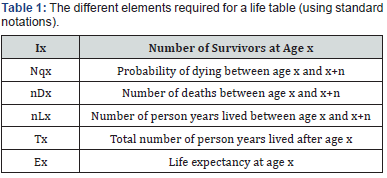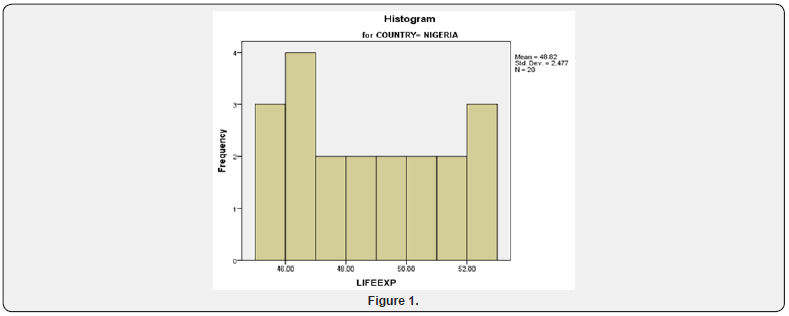Life Expectancy; Factors, Malaria the Most Common Disease Affecting Pregnant Women in Africa [Nigeria and Cameroon]-Juniper publishers
Global Journal of Reproductive
Medicine Juniper
Publishers
Authored by: İlker Etikan*
Introduction
Africa is the second largest and also the second most populous continent in the world. It comprises of 54 countries and total population of about 1.2 billion. The current population states that the population of the youth is higher to the one of the old because the average mean of the whole Africa population falls among the age of the youth. It is also confirmed by the world health organization (WHO) that Africa as a continent has the worst life expectancy at birth, while this is because more than half of the countries that falls under low life expectancy at birth are from African continent especially the sub-Sahara part. It may be due to some effects such as; climatic effects, economic effects, political effects, lack of access to good health center, etc. Life expectancy is the average mean length of life based on their birth, current age and other demographic factors including gender [1-4]. Life expectancy at birth is the breakdown of the death rate that arises across any form of age group in a given year be it young or old. The global life expectancy in the year 2015 was in the average mean of 71.4 years, which 73.8 years for the female while 69.1 years for the male. Since 1960, the life expectancy increased by 5 years between 2000 and 2015, which is said to be the fastest increase [5].
Life expectancy is a very crucial measure that effect the developing world’s striving to achieve socio and economic progress in health sector, education, sanitation, social safety and environmental management. Life expectancy shows the condition of a region or country, in developed countries, life expectancy is relatively high compared to the developing or under developed country because life expectancy is low. This may be due to lack of clean drinking water, proximity to the hospital or health care centre, etc. Some less developed countries, life expectancy at birth may be lower than life expectancy at age 1 , because of high infant mortality rates commonly due to lack of access to a clean water supply or infectious disease. To calculate life expectancy, a table has to be constructed called “Life Table”. It can only be constructed by considering two core factors; death rate of a total population and healthy life expectancy or disability free life expectancy. These two factors determine the average number of years a person is expected to live [6].
Life expectancy is usually reported at birth, although it can be applied to other ages as well, is a commonly used summary measure that can also be used to compare across countries. Life expectancy is calculated using life tables. Life Table consist of some elements that is derived after it is been constructed such as, the probability of surviving the next year, age of person at the particular time, number of death between ages, number of person lived after the particular age, life expectancy at the age. Before considering the construction of the life table, it is well known that there is a significant difference in the mortality rate of both the male and female. Therefore, the construction of life table is separately constructed between the both sex; the male and the female.
Construction of life tables
A life table explains the mortality rate of a population which also gets information about the length on life expectation. It contains columns with different interpretation. Through the construction of life table, many indicators are computed [7,8] (Table 1). This periodic table is the most used when constructing life table. It’s only based on the current age and death rate of different age circle. Furthermore, the actual life expectancy can also be calculated when everyone in a particular age range or define age group is dead. It is called a cohort life table [9,10]. This kind of table requires information or data over many years before a cohort life time table can be completed. An example on how it can be constructed and the mathematics involved can be downloaded from the statistical analysis website [11].

Definition: Life expectancy at birth tells the number of years a newborn baby would live at the period of birth to the time of death [12-14].
Historical Background of Life Expectancy
Nigeria: Nigeria is a federal republic in west Africa, surrounded by some neighboring countries like Benin, Cameroon, Ghana, Togo, Chad [9,13]. It official language is English with 3 major languages; Hausa, Igbo and Yoruba, and also lots of indigenous languages. It comprises 36 states and federal Capital Territory located in Abuja. Nigeria with total population of 186 million as at 2016 reported by the World Health Organization(WHO). Nigeria is the most populous and the most populated country in Africa, and 7th most populous country in the world. Nigeria life expectancy at birth is at a minimum of 36.98 in 1960, while the value for life expectancy at birth total (years) was approximately 52.98 as of 2015. The table below shows the life expectancy of both male and female since the year 1996 till 2015 (Table 2).

Cameroon: Cameroon, officially the republic of Cameroon is a country in central Africa with neighboring countries like; Nigeria, Equatorial Guinea, Central Africa Republic, Chad, and Republic of Congo. Her official languages are; English and French. Cameroon is one of the wettest places on earth because it receives plenty of rainfalls every year. As at 2016, the population of Cameroon was 23.4 million according to the World Health Organization (WHO) [14]. The life expectancy in Cameroon in 1960 was 41.52, while in 2015, life expectancy for Cameroon was 57.56 years. The table below shows the life expectancy of Cameroon at birth since the year 1996 till 2015 [2] (Table 3).

Reasons for Low Life Expectancy in Africa (Nigeria and Cameroon)
In most Africa countries, there is vivid record of imbalance of food when compared to her population growth. Africa which is said to be the hottest continent, the effects of food growth maybe from the lack of raindrops because more than half of the entire land surface of Africa consisting of dry lands and deserts due to lack of raindrops . Growing of foods and vegetations, mostly in the sub-Sahara part of Africa, result in a negative outcome during harvest due to low rainfall which affect the growth of negatively and during circulations, it cannot cover the whole population. Improper intake of food causes malnutrition which seems to be one of the major factors affecting low life expectancy at birth [15,16].
Illiteracy is very high in most Africa countries; one of it is affected by the low level of allocation from the government to build more schools for easy learning of dwellers which make it unavailable to most people [17]. Level of literacy is high in the major cities in Africa while in the rural part of Africa; the level of literacy is extremely low because there is no proximity to the education centre [18]. The United Nations Educational, Scientific and Cultural Organization (UNESCO) defines a literate person as someone who can read and write simple statement about their life [19,20], therefore education plays a big impact many aspects of life and also in the health aspect. Education teaches lots of things which include not to be ignorant of the latest things related to health issues. A well educated woman will is more likely keep their children healthy and also send them to school for additional literacy skills [12]. Others factors are; corrupt government officials, Availability of clean water, Widespread of diseases etc.
Malaria
Malaria is said to be one of the leading cause of death in Africa when it’s been compared with other diseases like HIV/ AIDS, Tuberculosis, Cholera, etc, according to World Health Organisation (WHO). Most of these disease are common in Africa due to the climatic condition of the part of the globe, lack of good infrastructural facilities such as good drainage, drinking water, low level of literacy (lack of knowledge about these disease) and again poverty; because majority of the population in Africa lives below normal standard of living [16]. It is an old disease which was originated in Africa. Hippocrates, the father of medicine born in ancient GREECE was the first to describe the manifestations of the disease [17]. Malaria is an infectious disease caused by mosquitoes after bitten, with symptoms like fever, headache, vomiting and tiredness. The manifestation of these (symptoms) begins after 10 to 15 days after being bitten by the host [21]. Malaria is caused by a parasitic protozoan’s carried and transmitted through the female mosquitoes (Anopheles). It occurs once bitten by the Anopheles mosquito. It releases the plasmodium parasite into human blood stream. During pregnancy, the immune system runs at a very low speed, this is to ensure the featus rejected as something strange. This simply means that the body will not be able to fight many infection and illness. Malaria during pregnancy has a high probability of losing the baby, premature delivery, and also can lead to the baby and the mother. Pregnant women are 3 times likely to contact any disease compared to when she is not. This is due their low level of immunity [19,8]. To prevent malaria, the World Health Organization (WHO) current guidelines are
I. Use of Long Lasting Insecticide Net (LLIN) to prevent mosquitoes from biting. It is also applicable to everybody because it is a well treated net.
II. Intermittent Preventive Treatment In Pregnancy (IPTP) with Sulfadoxine-Pyrimethamine (SP) as part of antenatal care service and taking iron with folic acid supplement as a routine [22].
Methods
The study of life expectancy at birth in Africa; between Nigeria and Cameroon, the periodic life expectancy table at birth is extracted from the World Data Atlas, Health data base. The life expectancy at birth extracted for only 20 years ranging from 1996 to 2015 estimated in the 2018 revision of World Data atlas, Health. The source contains the most recent used life expectancy table at birth which was as at 2016.
Results
The data is analyzed by the use of IBM SPSS 20, using the t-test method. The t-test is used to compare two average mean telling if there are different from each other. The t-test also tells how significant the differences are; Also, t-test tells by comparing the means of the two groups and letting you know the probability of those results happening by chance. In the comparison of the two countries, the results shows that Cameroon with the mean of 53.1185 and standard deviation of 2.809 09 and standard error mean of 0.62813 greater than Nigeria having the mean of 48.8250 with standard deviation of 2.47656 and standard error of 0.55378 (Table 4). The minimum and the maximum age of life expectancy in Nigeria respectively is 45.88 and 52.98 while the minimum and the maximum age of life expectancy in Cameroon is 49.51 and 57.56 respectively. This also vividly show that there is a significant different in the comparison between the two countries. Therefore we strongly reject null hypothesis that states that there is a significant difference in the life expectancy of Nigeria and Cameroon. This is because our p-value 0.00 is greater than the significant level 0.05 that is we reject null hypothesis (Figure 1-3).




Comments
Post a Comment